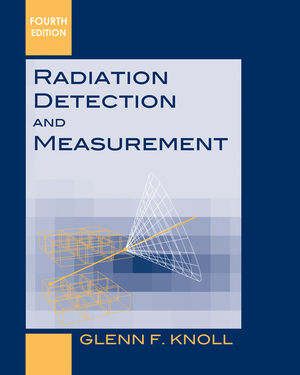|
Textbook
Radiation Detection and Measurement, 4th EditionISBN: 978-0-470-13148-0
Hardcover
864 pages
August 2010, ©2011
 |
||||||
I. Units And Definitions.
II. Fast Electron Sources.
III. Heavy Charged Particle Sources.
IV. Sources Of Electromagnetic Radiation.
V. Neutron Sources.
Chapter 2 Radiation Interactions.
I. Interaction Of Heavy Charged Particles.
II. Interaction Of Fast Electrons.
III. Interaction Of Gamma Rays.
IV. Interaction Of Neutrons.
V. Radiation Exposure And Dose.
Chapter 3 Counting Statistics And Error Prediction.
I. Characterization Of Data.
II. Statistical Models.
III. Applications Of Statistical Models.
IV. Error Propagation.
V. Optimization Of Counting Experiments.
VI. Limits Of Detectability.
VII. Distribution Of Time Intervals.
Chapter 4 General Properties Of Radiation Detectors.
I. Simplified Detector Model.
II. Modes Of Detector Operation.
III. Pulse Height Spectra.
IV. Counting Curves And Plateaus.
V. Energy Resolution.
VI. Detection Efficiency.
VII. Dead Time.
Chapter 5 Ionization Chambers.
I. The Ionization Process In Gases.
II. Charge Migration And Collection.
III. Design And Operation Of Dc Ion Chambers.
IV. Radiation Dose Measurement With Ion Chambers.
V. Applications Of Dc Ion Chambers.
VI. Pulse Mode Operation.
Chapter 6 Proportional Counters.
I. Gas Multiplication.
II. Design Features Of Proportional Counters.
III. Proportional Counter Performance.
IV. Detection Efficiency And Counting Curves.
V. Variants Of The Proportional Counter Design.
VI. Micropattern Gas Detectors.
Chapter 7 Geiger-Mueller Counters.
I. The Geiger Discharge.
II. Fill Gases.
III. Quenching.
IV. Time Behavior.
V. The Geiger Counting Plateau.
VI. Design Features.
VII. Counting Efficiency.
VIII. Time-To-First-Count Method.
IX. G-M Survey Meters.
Chapter 8 Scintillation Detector Principles.
I. Organic Scintillators.
II. Inorganic Scintillators.
III. Light Collection And Scintillator Mounting.
Chapter 9 Photomultiplier Tubes And Photodiodes.
I. Introduction.
II. The Photocathode.
III. Electron Multiplication.
IV. Photomultiplier Tube Characteristics.
V. Ancillary Equipment Required With Photomultiplier Tubes.
VI. Photodiodes As Substitutes For Photomultiplier Tubes.
VII. Scintillation Pulse Shape Analysis.
VIII. Hybrid Photomultiplier Tubes.
IX. Position-Sensing Photomultiplier Tubes.
X. Photoionization Detectors.
Chapter 10 Radiation Spectroscopy With Scintillators.
I. General Considerations In Gamma-Ray Spectroscopy.
II. Gamma-Ray Interactions.
III. Predicted Response Functions.
IV. Properties Of Scintillation Gamma-Ray Spectrometers.
V. Response Of Scintillation Detectors To Neutrons.
VI. Electron Spectroscopy With Scintillators.
VII. Specialized Detector Configurations Based On Scintillation.
Chapter 11 Semiconductor Diode Detectors.
I. Semiconductor Properties.
II. The Action Of Ionizing Radiation In Semiconductors.
III. Semiconductors As Radiation Detectors.
IV. Semiconductor Detector Configurations.
V. Operational Characteristics.
VI. Applications Of Silicon Diode Detectors.
Chapter 12 Germanium Gamma-Ray Detectors.
I. General Considerations.
II. Configurations Of Germanium Detectors.
III. Germanium Detector Operational Characteristics.
IV. Gamma-Ray Spectroscopy With Germanium Detectors.
Chapter 13 Other Solid-State Detectors.
I. Lithium-Drifted Silicon Detectors.
II. Semiconductor Materials Other Than Silicon Or Germanium.
III. Avalanche Detectors.
IV. Photoconductive Detectors.
V. Position-Sensitive Semiconductor Detectors.
Chapter 14 Slow Neutron Detection Methods.
I. Nuclear Reactions Of Interest In Neutron Detection.
II. Detectors Based On The Boron Reaction.
III. Detectors Based On Other Conversion Reactions.
IV. Reactor Instrumentation.
Chapter 15 Fast Neutron Detection And Spectroscopy.
I. Counters Based On Neutron Moderation.
II. Detectors Based On Fast Neutron-Induced Reactions.
III. Detectors That Utilize Fast Neutron Scattering.
Chapter 16 Pulse Processing.
I. Overview Of Pulse Processing.
II. Device Impedances.
III. Coaxial Cables.
IV. Linear And Logic Pulses.
V. Instrument Standards.
VI. Summary Of Pulse-Processing Units.
VII. Application Specific Integrated Circuits (ASICS).
VIII. Components Common To Many Applications.
Chapter 17 Pulse Shaping, Counting, And Timing.
I. Pulse Shaping.
II. Pulse Counting Systems.
III. Pulse Height Analysis Systems.
IV. Digital Pulse Processing.
V. Systems Involving Pulse Timing.
VI. Pulse Shape Discrimination.
Chapter 18 Multichannel Pulse Analysis.
I. Single-Channel Methods.
II. General Multichannel Characteristics.
III. The Multichannel Analyzer.
IV. Spectrum Stabilization And Relocation.
V. Spectrum Analysis.
Chapter 19 Miscellaneous Detector Types.
I. Cherenkov Detectors.
II. Gas-Filled Detectors In Self-Quenched Streamer Mode.
III. High-Pressure Xenon Spectrometers.
IV. Liquid Ionization And Proportional Counters.
V. Cryogenic Detectors.
VI. Photographic Emulsions.
VII. Thermoluminescent Dosimeters And Image Plates.
VIII. Track-Etch Detectors.
IX. Superheated Drop Or "Bubble Detectors".
X. Neutron Detection By Activation.
XI. Detection Methods Based On Integrated Circuit Components.
Chapter 20 Background And Detector Shielding.
I. Sources Of Background.
II. Background In Gamma-Ray Spectra.
III. Background In Other Detectors.
IV. Shielding Materials.
V. Active Methods Of Background Reduction.
Appendix A The NIM, CAMAC, And VME Instrumentation Standards.
Appendix B Derivation Of The Expression For Sample Variance In Chapter 3.
Appendix C Statistical Behavior Of Counting Data For Variable Mean Value.
Appendix D The Shockley-Ramo Theorem For Induced Charge.



